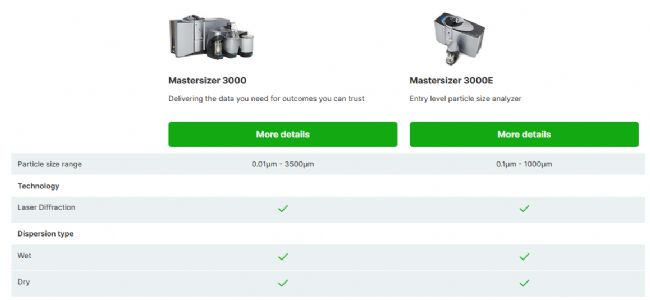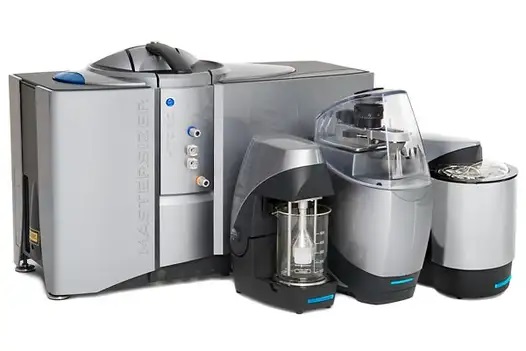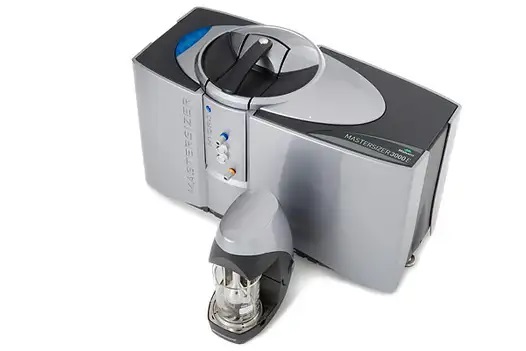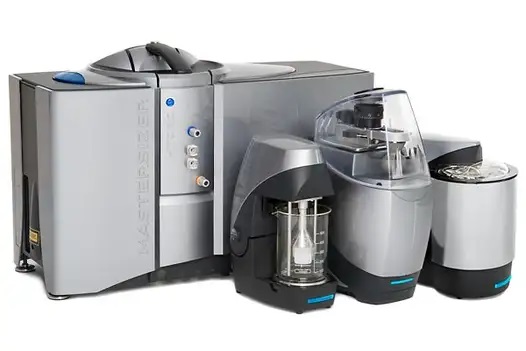- Mastersizer range Particle size analyzers

- Product Detail
- Company Profile
- Mastersizer range
- Class-leading particle sizing performance that generates the robust, reliable data you need, while making the best use of valuable laboratory space
- Intuitive software with built-in expertise that eases your analytical workload, enabling you to develop and run a variety of methods efficiently and effectively
- Flexible reporting capabilities so you can display your data exactly as you want it, customizable directly to your needs
- Rapid, effective sample preparation capabilities for suspensions, emulsions and powders, tailored for different sample requirements to provide the understanding you need to optimize your methods and ensure ongoing control
- Optical bench - Mastersizer 3000 delivers measurements from 10 nm to 3.5 mm using a single optical measurement path, making it suitable for an extremely wide range of applications. The dispersed sample passes though the measurement area of the optical bench, where a laser beam illuminates the particles. A series of detectors then accurately measure the intensity of light scattered by the particles within the sample for both red and blue light wavelengths and over a wide range of angles.
- Sample dispersion units - Mastersizer 3000 offers a choice of six wet dispersion accessories to handle an extended range of sample volumes and a wide variety of dispersants. A state-of-the-art dry dispersion system enables rapid and reproducible powder dispersion, even for more fragile materials. Sample dispersion units ensure that particles are delivered to the measurement area of the optical bench at the correct concentration and in a suitable stable state of dispersion to ensure accurate, reproducible measurements
- Mastersizer software - Mastersizer 3000 software meets the growing demand for easy-to-use instruments that deliver excellent results without constant input from experts. The software controls the system during the measurement process, analyzing scattering data to calculate a particle size distribution. Its intuitive interface guides users through every stage of the process, from selecting a robust method through to routine measurement and result reporting. In-built expert advice on method performance and results quality reduces training requirements and makes particle size analysis simpler and faster.
- Particle size range from 0.1 – 1000µm
- Manual dispersion units only
- Basic software, with updates and bug fixes only
- Anytime upgrade option to Mastersizer 3000E Extended
- Automated wet sample dispersion units supported
- All the advanced software functionality offered with the Mastersizer 3000, including updates, bug fixes and upgrades
- Optical bench - A dispersed sample passes though the measurement area of the optical bench, where a laser beam illuminates the particles. A series of detectors then accurately measure the intensity of light scattered by the particles within the sample over a wide range of angles.
- Sample dispersion units (accessories). Sample dispersion is controlled by a range of wet and dry dispersion units. These ensure the particles are delivered to the measurement area of the optical bench at the correct concentration and in a suitable, stable state of dispersion.
- Instrument software. The Mastersizer 3000E software controls the system during the measurement process and analyzes the scattering data to calculate a particle size distribution.
World's most popular particle size analyzers
The Mastersizer range of laser diffraction particle size analyzers set the standard for delivering rapid, accurate particle size distributions for both wet and dry dispersions. From assessing product uniformity and solubility, through to optimising packing density to improve final product performance and controlling powder flowability to increase manufacturing efficiency, particle size analysis is critical to understanding and controlling a wide range of properties. The Mastersizer range, with its intuitive software and industry-leading design and ergonomics, enables users to make these particle sizing measurements fast and routine.

Mastersizer 3000
Delivering the data you need for outcomes you can trust

Organizations around the world rely on the Mastersizer 3000 laser diffraction particle size analyzer to consistently deliver the accurate, robust, reliable data that informs critical decision-making throughout R&D and manufacturing processes. Such knowledge-driven decisions are fundamental to ensuring the quality and performance of a diverse range of raw materials, intermediates and final products.
The market-leading Mastersizer 3000 particle size analyzer is a versatile, compact instrument that aligns with the analytical requirements, resource constraints and demanding workflows of today’s laboratories. Combining expert engineering and applications know-how, it delivers:
How it works
The Mastersizer 3000 uses the technique of laser diffraction to measure the particle size and particle size distribution of materials. It does this by measuring the intensity of light scattered as a laser beam passes through a dispersed particulate sample. This data is then analyzed to calculate the size of the particles that created the scattering pattern. Three main elements enable the system to consistently and reliably deliver the accurate, robust particle sizing data that is central to the effective operation of so many industrial processes.
![[Badge-gold.jpg] 637418184549717797WX.jpg](https://p3.aprimocdn.net/malvernpanalytical/8df3701f-ab45-437e-8e12-ada00150d525/637418184549717797WX_Original%20file.jpg) |
Our trusted Mastersizer 3000 system has a gold seal of approval - see our global reviews or read what our customers think of the Mastersizer 3000 system. |
Powder flowability is important in maintaining manufacturing efficiency for many processes. Inconsistent powder flow can directly affect product quality variables such as the content uniformity of pharmaceutical dosage forms, or may lead to process variability as powder feed inconsistencies change the effectiveness of particle size reduction processes. Powder flow is a critical consideration in the manufacture of sintered products using additive manufacturing or 3D-printing techniques. Here, poor flow during powder bed deposition may lead to variations in powder bed density, resulting in defects that reduce the strength of the finished part.
Particle size and particle size distribution analysis are critical to understanding the flow properties of a powder, since these characteristics help predict how particles within the powder will pack and lock together. Powders that have a large particle size with a narrow size distribution tend to exhibit good flowability. Those with a small particle size, or a broad particle size distribution, tend towards poorer flowability because of the greater surface area of contact that exists between the particles and the ability of the fine particles present to fill the voids.
Packing density of particles influences the success of many processes, including mould-filling in ceramic and metal component production, powder coating, and the solids loading of suspensions. The way that particles pack together is a function of both their size and size distribution. Larger particles pack less efficiently than smaller ones, creating bigger voids. Broadening the particle size distribution improves packing efficiency by allowing smaller particles to pack the spaces between larger ones. Minimizing voidage is crucial to producing flaw-free sintered components. In powder coating, close packing enables efficient melting at lower temperatures, giving more time for cross-linking reactions between polymer particles for a better finish.
Particle packing also influences the rheology of suspensions, principally their viscosity. A mix of large and small particles has the least impact on the viscosity of the system because of their greater packing efficiency, a phenomenon that can be exploited to increase the solids loading of suspensions such as paints and ceramics.
Stability of the suspensions and emulsions used and produced in industries such as pharmaceuticals and foods is important in ensuring product efficacy, acceptability, and success. Dispersion stability and gravitational separation are both key elements.
Dispersion stability: Achieving a stable dispersion requires control of the forces of adhesion and cohesion that exist between particles within a medium. These forces can lead to flocculation of emulsions or the creation of agglomerates within suspensions and powders. The risk of poor dispersion stability increases with decreasing particle size and can significantly impact processing. It may lead to powder conveyance issues within manufacturing processes, or problems with final product performance, such as the formation of agglomerates that give rise to imperfections in coatings and paints. Particle size and particle size distribution analysis is used in the management of dispersion stability risk and to identify the impact of stability problems on product performance and acceptance.
Gravitational separation: Improving the stability of a suspension or emulsion to gravitational separation relies on balancing the gravitational pull on the particles, a function of particle size and density, with the up-thrust of the suspending fluid, which depends on viscosity. In emulsions, particle size analysis is used to assess the likelihood of creaming, to which larger droplets are prone, and to monitor stability to flocculation and coalescence over time. Since droplet size and the degree of flocculation may also affect characteristics such as the mouthfeel of a food or viscosity of a drink, particle size should be measured routinely when optimizing and manufacturing emulsion formulations.
Dissolution rates of materials are influenced by the specific surface area of the particulates. Increasing the specific surface area of particles by reducing their size accelerates the dissolution process. This correlation is especially important in pharmaceutical products, where dissolution directly impacts the bioavailability of a drug substance. Agrochemical and detergent manufacturers must also manage particle size to control the dissolution and release rates of active components within a formulation.
Ease of inhalation is an important criterion, both for preventing human inhalation of harmful particles and to optimize drug deposition in the respiratory tract. For all orally-inhaled and nasal drug products (OINDPs), particle size is a critical parameter, with clear size ranges specified for deposition and retention in the nasal cavity and for penetration to different areas of the lungs. In contrast, manufacturers of products such as cleaning materials and hairsprays must control fines to prevent inhalation, making particle size analysis essential to safety testing.
Reaction rates in solid systems are often a function of the specific surface area of the particles involved. The finer the particles, the larger their surface area to volume ratio, which promotes higher reaction rates. This is important in industries as diverse as cement, where particle size impacts the speed of hardening of cement products, and catalyst production, where particle size must be tailored to optimize reaction rates or ensure the effective scavenging of pollutants.
Optical properties such as the light scattering ability of particles are exploited by paint, coatings and pigments manufacturers. The way a particle scatters light depends on its size, so manipulating the size of particles in a surface coating influences performance parameters such as hue and tint strength, product coverage and gloss.
Consumer perception of products such as foodstuffs is often influenced by particle size. For example, the particle size of coffee, the extent to which it is ground, impacts both the flavour released and the time required to brew. A fine particle size in chocolate gives a smooth mouthfeel, frequently perceived as superior to a grainy texture.
General
| Particle size | Suspensions, emulsions, dry powders |
|---|---|
| Principle | Laser light scattering |
| Analysis | Mie and Fraunhofer scattering |
| Data acquisition rate | 10 kHz |
| Typical measurement time | <10 sec |
| Dimensions (W, D, H) | 690mm x 300mm x 450mm |
| Weight | 30 kg |
| Red light source | Max. 4mW He-Ne, 632.8nm |
|---|---|
| Blue light source | Max. 10mW LED, 470nm |
| Lens arrangement | Reverse Fourier (convergent beam) |
| Effective focal length | 300mm |
| Arrangement | Log-spaced array |
|---|---|
| Angular range | 0.015 - 144 degrees |
| Alignment | Automatic |
| Particle size | 0.01 - 3500 µm * |
|---|---|
| Number of size classes | 100 (user adjustable) |
| Accuracy | Better than 0.6% ** |
| Precision / Repeatability | Better than 0.5% variation * |
| Reproducibility | Better than 1% variation * |
| 21 CFR part 11 | Enables an operating mode that assists with ER/ES compliance |
|---|
| Laser safety | Class 1, IEC60825-1:2007 and CFR Chapter I: Sub-chapterJ: Part 1040 (CDRH) |
|---|---|
| Regulatory testing | RoHS and WEEE compliant CE / FCC compliant Meets requirements of the European Low Voltage directive |
| Power | 100/240 v, 50/60 Hz 50W (no dispersion units connected) 200W maximum (2 dispersion units connected) |
|---|---|
| Humidity | 80% maximum for temperatures up to 31°C, decreasing linearly to 50% at 40°C. Non condensing. |
| Operating temperature (°C) | +5°C to +40°C |
| Product storage temperature | -20°C to +50°C |
| Ingress Protection (IP) rating | IP41B |
| * | Sample and sample preparation dependent. |
|---|---|
| ** | Accuracy defined for the measurement of monomodal latex standards. This specification accounts for the manufacturer’s uncertainty in the latex size. Sample and sample preparation dependant. |
| Patents | The Mastersizer 3000 optical bench is protected by patents; US6,778,271 and related filings; GB2,340,932; together with patents based on applications WO2013038161, WO2013038160 and WO2013038159. Hydro MV and LV protected by EP1167946A2 and related filings. |

A window into deeper materials analysis
In this way, it helps scientists, researchers, and quality-control managers understand their materials better, develop methods faster, and simplify troubleshooting.

Small volume wet sample dispersion

Medium volume automated dispersion unit.

Large volume wet sample dispersion.

Flexible volume wet dispersion

Small volume entry level wet dispersion unit

Effective Chocolate production quality control

State-of-the-art dry powder dispersion

Aero Funnel Sample Feeder
Rapid QC measurements for bulk powder samples
Mastersizer 3000E
Entry level particle size analyzer

The Mastersizer 3000 is highly regarded as the premier laser diffraction particle size analysis instrument on the market for design, performance and software user experience. However, some customers do not immediately need the advanced functionality that the Mastersizer 3000 offers. Malvern Panalytical have therefore introduced an entry level instrument to the Mastersizer product family which is based upon the proven design of the Mastersizer 3000 but with more basic performance and software functionality.
The Mastersizer 3000E provides a cost-effective, entry level particle sizing system which can be upgraded as required. It is available with two different performance levels:
Mastersizer 3000E BasicThe Mastersizer 3000E uses the technique of laser diffraction to measure the size of particles. It does this by measuring the intensity of light scattered as a laser beam passes through a dispersed particulate sample. This data is then analysed to calculate the size of the particles that created the scattering pattern.
A typical system is made up of three main elements:
Our global sales and support network ensures that wherever you are, we’ve got you covered
Free access to exclusive content: webinars, videos, whitepapers, and much more
Whatever your application or industry, we have the solutions, support, and expertise you need
Innovative, yet robust and reliable instruments you can trust for continuous, precise, and rapid analysis
General
| Particle size | Suspensions, emulsions, dry powders |
|---|---|
| Principle | Laser light scattering |
| Analysis | Mie and Fraunhofer scattering |
| Data acquisition rate | 10 kHz |
| Typical measurement time | <10 sec |
| Dimensions (W, D, H) | 690mm x 300mm x 450mm |
| Weight | 30 kg |
| Red light source | Max. 4mW He-Ne, 632.8nm |
|---|---|
| Blue light source | None |
| Lens arrangement | Reverse Fourier (convergent beam) |
| Effective focal length | 300mm |
| Arrangement | Log-spaced array |
|---|---|
| Angular range | 0.032 - 60 degrees |
| Alignment | Automatic |
| Particle size | 0.1 - 1000 µm * |
|---|---|
| Number of size classes | 100 (user adjustable) |
| Accuracy | Better than 0.6% ** |
| Precision / Repeatability | Better than 0.5% variation * |
| Reproducibility | Better than 1% variation * |
| Laser safety | Class 1, IEC60825-1:2007 and CFR Chapter I: Sub-chapterJ: Part 1040 (CDRH) |
|---|---|
| Regulatory testing | RoHS and WEEE compliant CE / FCC compliant Meets requirements of the European Low Voltage directive |
| Power | 100/240 v, 50/60 Hz 50W (no dispersion units connected) 200W maximum (2 dispersion units connected) |
|---|---|
| Humidity | 80% maximum for temperatures up to 31°C, decreasing linearly to 50% at 40°C. Non condensing. |
| Product storage temperature | -20°C to +50°C |
| Ingress Protection (IP) rating | IP41B |
| Operating temperature (°C) | +5°C to +40°C |
| * | Sample and sample preparation dependent. |
|---|---|
| ** | Accuracy defined for the recovery of the mean size of a narrow log-normal distribution. Sample and sample preparation dependant. |
| Patents | The Mastersizer 3000E optical bench is protected by patent GB2,340,932; together with patents based on applications WO2013038161 and WO2013038159. Hydro MV and LV protected by EP1167946A2 and related filings. |

A window into deeper materials analysis
The Hydro Insight is a dynamic imaging accessory that sits alongside the Mastersizer 3000, providing insights that go beyond particle size distribution to particle images and quantitative particle shape data.
In this way, it helps scientists, researchers, and quality-control managers understand their materials better, develop methods faster, and simplify troubleshooting.

Small volume wet sample dispersion
The Hydro SV is a simple, cost effective liquid dispersion unit designed to enable particle size analysis using small volumes of sample and dispersant.

Flexible volume wet dispersion
A unique dip-in wet sample dispersion unit that can be used with standard laboratory glassware. Suitable for a wide variety of dispersant volumes and particle size ranges.

Small volume entry level wet dispersion unit
The Hydro SM is a cost effective wet sample dispersion unit designed for measuring samples in non-aqueous dispersants where solvent usage needs to be minimized.

Routine particle size analysis for bulk dry powder samples
The Aero M dry powder disperser enables bulk dry powder samples to be measured using the Mastersizer 3000E laser diffraction particle size analyzer. Its simple design ensures that it is easy to use and maintain, delivering robust, reproducible particle size distribution measurements as part of routine production or quality control operations.

Rapid QC measurements for bulk powder samples
The Aero funnel sample feeder is designed to help users achieve rapid, reproducible bulk dry powder particle size measurements by allowing samples to be added directly to the Aero S and Aero M dry powder dispersion units without opening the dispersion unit lid. This speeds up and simplifies the process of introducing samples for analysis, decreasing the time required to obtain results.

Effective Chocolate production quality control
The goal of chocolate production is to produce a product with a consistent taste and mouthfeel in an economical and efficient way. Control of the cocoa and milk solids particle size and particle size distribution is critical to achieving this objective. The Mastersizer 3000 Chocosizer is designed to support chocolate production and quality control by providing a simple method for fast, reliable chocolate particle size analysis.

Medium volume automated dispersion unit.
The Hydro MV is a medium volume unit for the controlled, automated wet dispersion of samples for particle size analysis. Suitable for both aqueous and non-aqueous applications, it is especially useful when sample size is limited and/or dispersant use must be minimized.
Protect your investment and ensure optimized performance at all times with Malvern Panalytical's service plans.
When you purchase a Malvern Panalytical product we understand that this is just the first stage of a working relationship that will last for the lifetime of the instrument. Depending on your needs, Malvern Panalytical will provide the support for your business.
-
We draw on the power of our analytical instruments and services to make the invisible visible and the impossible possible. Through the chemical, physical and structural analysis of materials, our high-precision analytical systems and top-notch services support our customers in creating a better world, helping them to improve everything from the energies that power us and the materials we build with, to the medicines that cure us and the foods we enjoy. We partner with many of the world’s biggest companies, universities and research organizations. They value us not only for the power of our solutions, but also for the depth of our expertise, collaboration and integrity. With over 2200 employees, we serve the world, and we are part of Spectris plc, the world-leading precision measurement group.
Malvern Panalytical. We’re BIG on small?.
| Request Information |
| Other Products |
| Related Products |
| Recently viewed products |
- SiteMap



